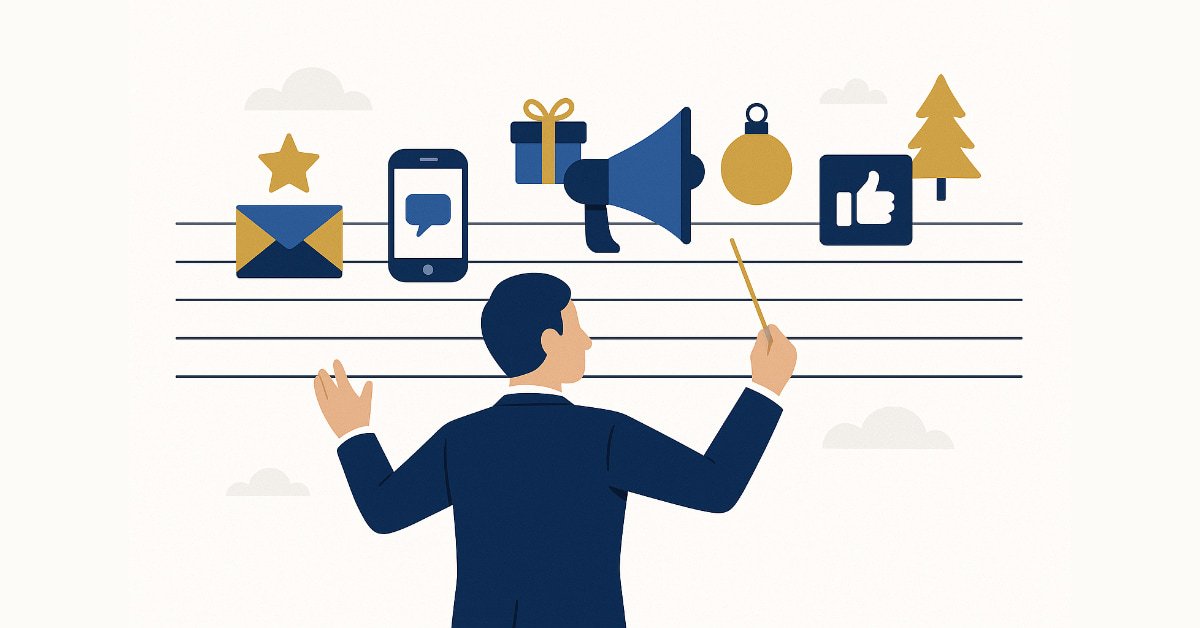Holiday Campaigns Done Right: How to Coordinate Across Every Channel
Holiday marketing is a big deal for many brands. The pressure’s on to deliver big results, but relying on disconnected campaigns can end up competing with one another instead of feeling connected. When your email, SMS, social, and ads all tell a consistent story, you turn chaos into a cohesive narrative and engagement into revenue.
This post will walk you through how to plan, orchestrate, and measure multi-channel holiday campaigns that feel seamless to customers and stress-free for your team.
1. Start with a Single Strategy (Not Separate Campaigns)
Before you start writing subject lines or designing ad creative, zoom out. What story are you telling this holiday season? Every channel should play a role in telling that story.
Create one master campaign brief that outlines your theme, target segments, offer calendar, and brand voice. Then, adapt messaging for each channel’s purpose. For example, email to inform, SMS to nudge, paid ads to attract, and organic social to engage.
When you start from one plan, your campaigns work in harmony rather than in parallel.
2. Build Your Timeline Backward
Holiday chaos is predictable, which means it’s preventable. The key is to map your entire lifecycle sequence at least 6–8 weeks before launch.
Use your campaign goals to build backward:
Set milestones (creative finalized, approvals complete, test sends scheduled)
Lock your send cadence (email, SMS, and paid frequency)
Create space for QA and segmentation tests
If your brand runs multiple offers (e.g., Black Friday, Cyber Monday, and extended holiday sales), make sure the transition between them is clean. Communicate clearly when an offer ends and the next begins. Consistency builds trust.
3. Align Your Messaging Across Channels
Your customer shouldn’t have to decode your marketing. Whether they see an ad, open an email, or visit your site, the tone, visuals, and CTA should feel instantly familiar.
Start by aligning three key elements:
Offer framing: Use the same headline and discount percentage across all touchpoints
Visual identity: Keep brand colors, imagery, and typography consistent
CTA hierarchy: Match your main conversion goals (e.g., “Shop the Gift Guide”) everywhere
Cohesion isn’t repetition. Tailor copy to fit the channel. An SMS reminder might say, “Don’t miss 20% off gifts today only 🎁,” while the email gives more context and visuals. The goal is recognition, not redundancy.
4. Use Lifecycle Triggers to Automate and Personalize
The holidays move fast. Manual sending won’t cut it. That’s where marketing automation becomes your secret weapon.
Set up triggered campaigns tied to behaviors and lifecycle stages:
Cart and browse abandonment: Remind high-intent shoppers with urgency messaging
Post-purchase flows: Thank buyers and suggest complementary gifts
Winback campaigns: Target lapsed customers with exclusive early access
Automation ensures customers get the right message at the right time, even while your team is deep in campaign mode.
5. Connect Data for Smarter Orchestration
When your platforms don’t talk, your customers get mixed messages. Use integrations between your email, SMS, paid, and ecommerce tools (if you're using them) to unify engagement data.
That connection lets you:
Suppress customers who have already purchased from your paid campaigns
Adjust email content based on SMS engagement
Optimize budget allocation based on performance by channel
If you’re unsure how to orchestrate this, partner with a lifecycle marketing agency experienced in marketing automation strategy and customer lifecycle management. They’ll help you set up tracking, attribution, and dynamic segmentation that keeps every channel aligned.
6. Measure What Matters (and Learn for Next Year)
After the holidays, don’t just celebrate, analyze. Your most valuable insights often come after the campaign ends.
Key metrics to review:
Revenue per channel and customer
Conversion and engagement lift for multi-channel vs single-channel touchpoints
Timing impact (early access vs last-minute sends)
Then, document your findings. The brands that improve each year aren’t just lucky; they’re learning from their lifecycle data.
7. Bonus: The Power of Customer Experience
It’s easy to get caught up in promotions, but remember: the holidays are emotional. Deliver a positive experience through thoughtful touches; clear shipping updates, personalized gift recommendations, and a sincere thank-you post-purchase.
Consistency across every channel builds not only revenue but long-term loyalty.
Conclusion
When your holiday campaigns are connected, customers notice. They feel the consistency, trust your brand more, and buy with confidence.
So this year, plan early, automate wisely, and think like an orchestra conductor. Every channel has a part to play, and together they create the music of a great customer experience.

